Report: Business and Transport Facility at Great Portland Station
VerifiedAdded on 2022/11/26
|13
|3267
|275
Report
AI Summary
This report provides an overview of the proposed business and transport facility at Great Portland Station in London. It details the history and significance of the location, including its status as a major transport hub and its historical importance as the site of the world's first underground railway station. The report outlines the proposed four-story building's uses, including showrooms, retail spaces, fitness centers, hotels, conference facilities, and art galleries. It discusses construction organization, temporary buildings, marketing strategies for businesses within the facility, and the difference between construction and facility plans. Additionally, the report examines the necessary materials for construction plan development, situational plans, site plan considerations, the arrangement of temporary buildings, and the risks associated with construction loans, including short-term resource bases, high inflation rates, and exchange rate instability.
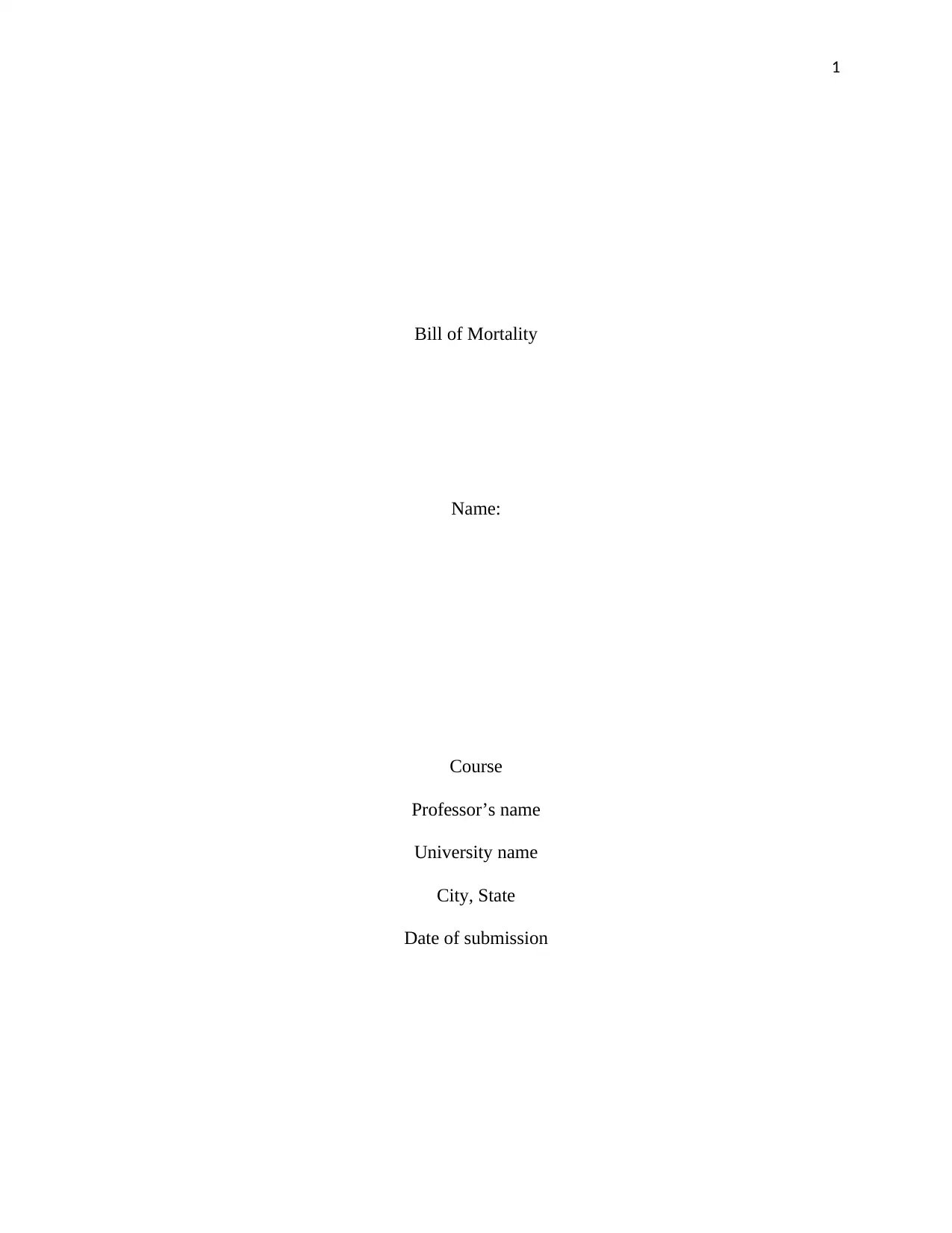
1
Bill of Mortality
Name:
Course
Professor’s name
University name
City, State
Date of submission
Bill of Mortality
Name:
Course
Professor’s name
University name
City, State
Date of submission
Paraphrase This Document
Need a fresh take? Get an instant paraphrase of this document with our AI Paraphraser
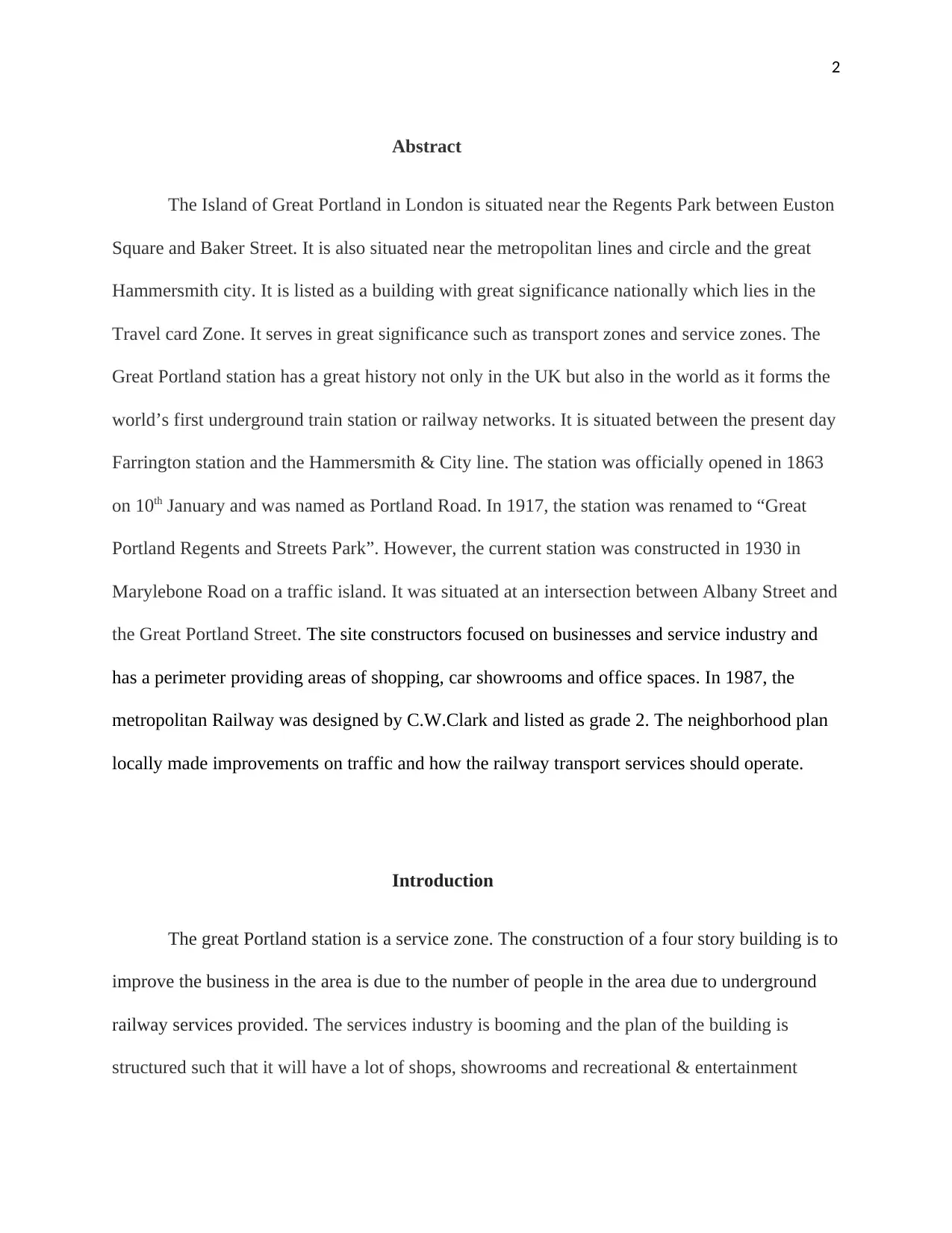
2
Abstract
The Island of Great Portland in London is situated near the Regents Park between Euston
Square and Baker Street. It is also situated near the metropolitan lines and circle and the great
Hammersmith city. It is listed as a building with great significance nationally which lies in the
Travel card Zone. It serves in great significance such as transport zones and service zones. The
Great Portland station has a great history not only in the UK but also in the world as it forms the
world’s first underground train station or railway networks. It is situated between the present day
Farrington station and the Hammersmith & City line. The station was officially opened in 1863
on 10th January and was named as Portland Road. In 1917, the station was renamed to “Great
Portland Regents and Streets Park”. However, the current station was constructed in 1930 in
Marylebone Road on a traffic island. It was situated at an intersection between Albany Street and
the Great Portland Street. The site constructors focused on businesses and service industry and
has a perimeter providing areas of shopping, car showrooms and office spaces. In 1987, the
metropolitan Railway was designed by C.W.Clark and listed as grade 2. The neighborhood plan
locally made improvements on traffic and how the railway transport services should operate.
Introduction
The great Portland station is a service zone. The construction of a four story building is to
improve the business in the area is due to the number of people in the area due to underground
railway services provided. The services industry is booming and the plan of the building is
structured such that it will have a lot of shops, showrooms and recreational & entertainment
Abstract
The Island of Great Portland in London is situated near the Regents Park between Euston
Square and Baker Street. It is also situated near the metropolitan lines and circle and the great
Hammersmith city. It is listed as a building with great significance nationally which lies in the
Travel card Zone. It serves in great significance such as transport zones and service zones. The
Great Portland station has a great history not only in the UK but also in the world as it forms the
world’s first underground train station or railway networks. It is situated between the present day
Farrington station and the Hammersmith & City line. The station was officially opened in 1863
on 10th January and was named as Portland Road. In 1917, the station was renamed to “Great
Portland Regents and Streets Park”. However, the current station was constructed in 1930 in
Marylebone Road on a traffic island. It was situated at an intersection between Albany Street and
the Great Portland Street. The site constructors focused on businesses and service industry and
has a perimeter providing areas of shopping, car showrooms and office spaces. In 1987, the
metropolitan Railway was designed by C.W.Clark and listed as grade 2. The neighborhood plan
locally made improvements on traffic and how the railway transport services should operate.
Introduction
The great Portland station is a service zone. The construction of a four story building is to
improve the business in the area is due to the number of people in the area due to underground
railway services provided. The services industry is booming and the plan of the building is
structured such that it will have a lot of shops, showrooms and recreational & entertainment
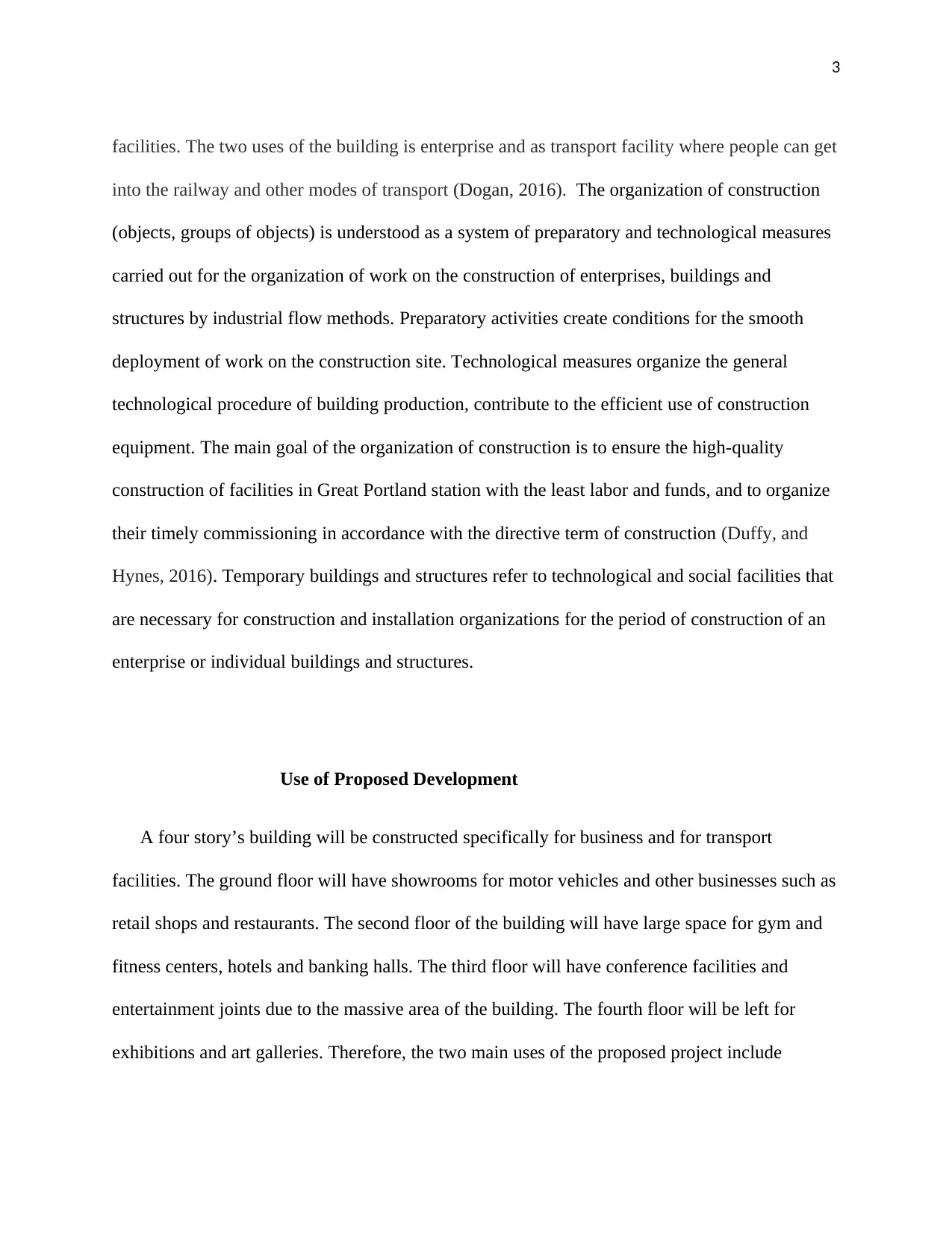
3
facilities. The two uses of the building is enterprise and as transport facility where people can get
into the railway and other modes of transport (Dogan, 2016). The organization of construction
(objects, groups of objects) is understood as a system of preparatory and technological measures
carried out for the organization of work on the construction of enterprises, buildings and
structures by industrial flow methods. Preparatory activities create conditions for the smooth
deployment of work on the construction site. Technological measures organize the general
technological procedure of building production, contribute to the efficient use of construction
equipment. The main goal of the organization of construction is to ensure the high-quality
construction of facilities in Great Portland station with the least labor and funds, and to organize
their timely commissioning in accordance with the directive term of construction (Duffy, and
Hynes, 2016). Temporary buildings and structures refer to technological and social facilities that
are necessary for construction and installation organizations for the period of construction of an
enterprise or individual buildings and structures.
Use of Proposed Development
A four story’s building will be constructed specifically for business and for transport
facilities. The ground floor will have showrooms for motor vehicles and other businesses such as
retail shops and restaurants. The second floor of the building will have large space for gym and
fitness centers, hotels and banking halls. The third floor will have conference facilities and
entertainment joints due to the massive area of the building. The fourth floor will be left for
exhibitions and art galleries. Therefore, the two main uses of the proposed project include
facilities. The two uses of the building is enterprise and as transport facility where people can get
into the railway and other modes of transport (Dogan, 2016). The organization of construction
(objects, groups of objects) is understood as a system of preparatory and technological measures
carried out for the organization of work on the construction of enterprises, buildings and
structures by industrial flow methods. Preparatory activities create conditions for the smooth
deployment of work on the construction site. Technological measures organize the general
technological procedure of building production, contribute to the efficient use of construction
equipment. The main goal of the organization of construction is to ensure the high-quality
construction of facilities in Great Portland station with the least labor and funds, and to organize
their timely commissioning in accordance with the directive term of construction (Duffy, and
Hynes, 2016). Temporary buildings and structures refer to technological and social facilities that
are necessary for construction and installation organizations for the period of construction of an
enterprise or individual buildings and structures.
Use of Proposed Development
A four story’s building will be constructed specifically for business and for transport
facilities. The ground floor will have showrooms for motor vehicles and other businesses such as
retail shops and restaurants. The second floor of the building will have large space for gym and
fitness centers, hotels and banking halls. The third floor will have conference facilities and
entertainment joints due to the massive area of the building. The fourth floor will be left for
exhibitions and art galleries. Therefore, the two main uses of the proposed project include
⊘ This is a preview!⊘
Do you want full access?
Subscribe today to unlock all pages.

Trusted by 1+ million students worldwide
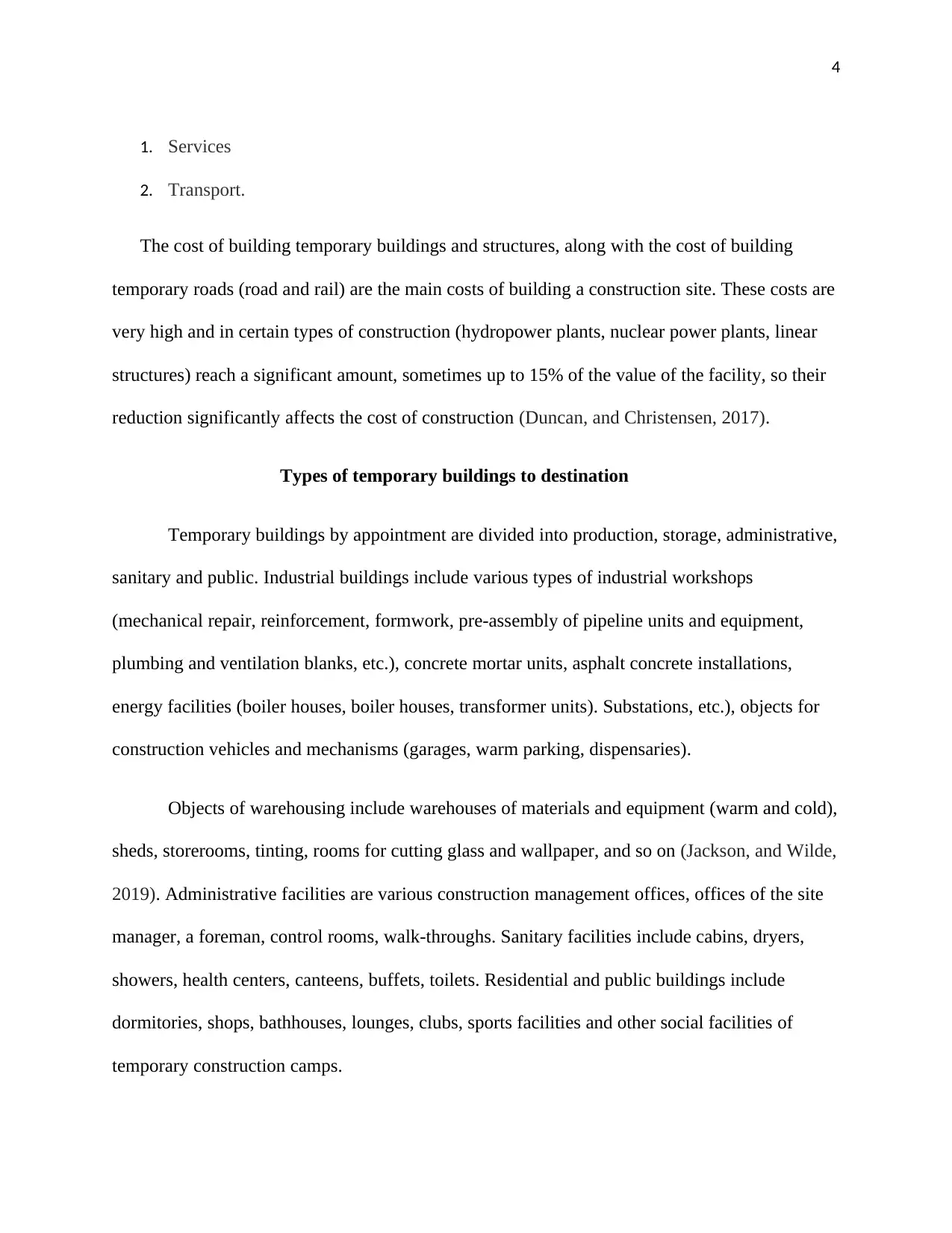
4
1. Services
2. Transport.
The cost of building temporary buildings and structures, along with the cost of building
temporary roads (road and rail) are the main costs of building a construction site. These costs are
very high and in certain types of construction (hydropower plants, nuclear power plants, linear
structures) reach a significant amount, sometimes up to 15% of the value of the facility, so their
reduction significantly affects the cost of construction (Duncan, and Christensen, 2017).
Types of temporary buildings to destination
Temporary buildings by appointment are divided into production, storage, administrative,
sanitary and public. Industrial buildings include various types of industrial workshops
(mechanical repair, reinforcement, formwork, pre-assembly of pipeline units and equipment,
plumbing and ventilation blanks, etc.), concrete mortar units, asphalt concrete installations,
energy facilities (boiler houses, boiler houses, transformer units). Substations, etc.), objects for
construction vehicles and mechanisms (garages, warm parking, dispensaries).
Objects of warehousing include warehouses of materials and equipment (warm and cold),
sheds, storerooms, tinting, rooms for cutting glass and wallpaper, and so on (Jackson, and Wilde,
2019). Administrative facilities are various construction management offices, offices of the site
manager, a foreman, control rooms, walk-throughs. Sanitary facilities include cabins, dryers,
showers, health centers, canteens, buffets, toilets. Residential and public buildings include
dormitories, shops, bathhouses, lounges, clubs, sports facilities and other social facilities of
temporary construction camps.
1. Services
2. Transport.
The cost of building temporary buildings and structures, along with the cost of building
temporary roads (road and rail) are the main costs of building a construction site. These costs are
very high and in certain types of construction (hydropower plants, nuclear power plants, linear
structures) reach a significant amount, sometimes up to 15% of the value of the facility, so their
reduction significantly affects the cost of construction (Duncan, and Christensen, 2017).
Types of temporary buildings to destination
Temporary buildings by appointment are divided into production, storage, administrative,
sanitary and public. Industrial buildings include various types of industrial workshops
(mechanical repair, reinforcement, formwork, pre-assembly of pipeline units and equipment,
plumbing and ventilation blanks, etc.), concrete mortar units, asphalt concrete installations,
energy facilities (boiler houses, boiler houses, transformer units). Substations, etc.), objects for
construction vehicles and mechanisms (garages, warm parking, dispensaries).
Objects of warehousing include warehouses of materials and equipment (warm and cold),
sheds, storerooms, tinting, rooms for cutting glass and wallpaper, and so on (Jackson, and Wilde,
2019). Administrative facilities are various construction management offices, offices of the site
manager, a foreman, control rooms, walk-throughs. Sanitary facilities include cabins, dryers,
showers, health centers, canteens, buffets, toilets. Residential and public buildings include
dormitories, shops, bathhouses, lounges, clubs, sports facilities and other social facilities of
temporary construction camps.
Paraphrase This Document
Need a fresh take? Get an instant paraphrase of this document with our AI Paraphraser
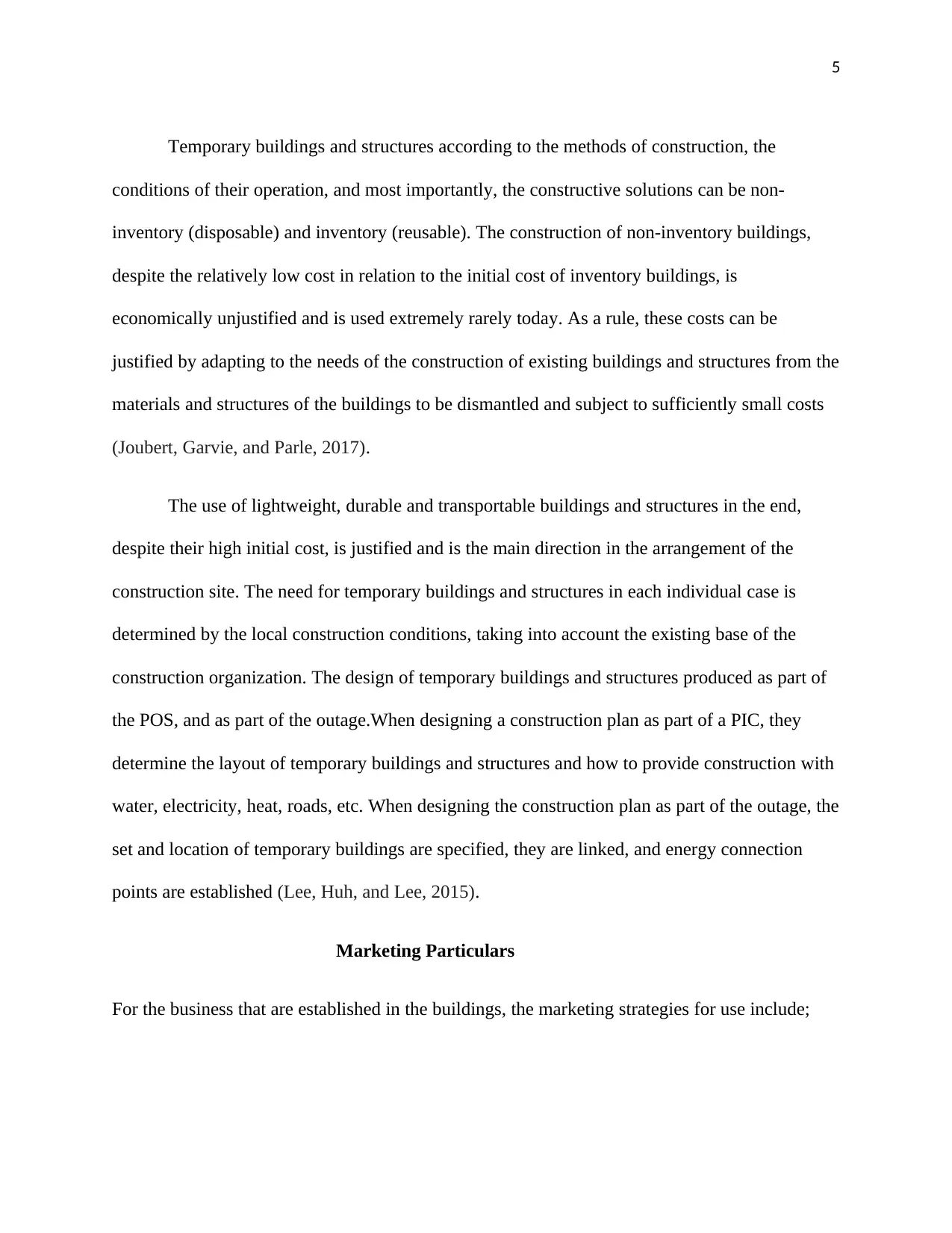
5
Temporary buildings and structures according to the methods of construction, the
conditions of their operation, and most importantly, the constructive solutions can be non-
inventory (disposable) and inventory (reusable). The construction of non-inventory buildings,
despite the relatively low cost in relation to the initial cost of inventory buildings, is
economically unjustified and is used extremely rarely today. As a rule, these costs can be
justified by adapting to the needs of the construction of existing buildings and structures from the
materials and structures of the buildings to be dismantled and subject to sufficiently small costs
(Joubert, Garvie, and Parle, 2017).
The use of lightweight, durable and transportable buildings and structures in the end,
despite their high initial cost, is justified and is the main direction in the arrangement of the
construction site. The need for temporary buildings and structures in each individual case is
determined by the local construction conditions, taking into account the existing base of the
construction organization. The design of temporary buildings and structures produced as part of
the POS, and as part of the outage.When designing a construction plan as part of a PIC, they
determine the layout of temporary buildings and structures and how to provide construction with
water, electricity, heat, roads, etc. When designing the construction plan as part of the outage, the
set and location of temporary buildings are specified, they are linked, and energy connection
points are established (Lee, Huh, and Lee, 2015).
Marketing Particulars
For the business that are established in the buildings, the marketing strategies for use include;
Temporary buildings and structures according to the methods of construction, the
conditions of their operation, and most importantly, the constructive solutions can be non-
inventory (disposable) and inventory (reusable). The construction of non-inventory buildings,
despite the relatively low cost in relation to the initial cost of inventory buildings, is
economically unjustified and is used extremely rarely today. As a rule, these costs can be
justified by adapting to the needs of the construction of existing buildings and structures from the
materials and structures of the buildings to be dismantled and subject to sufficiently small costs
(Joubert, Garvie, and Parle, 2017).
The use of lightweight, durable and transportable buildings and structures in the end,
despite their high initial cost, is justified and is the main direction in the arrangement of the
construction site. The need for temporary buildings and structures in each individual case is
determined by the local construction conditions, taking into account the existing base of the
construction organization. The design of temporary buildings and structures produced as part of
the POS, and as part of the outage.When designing a construction plan as part of a PIC, they
determine the layout of temporary buildings and structures and how to provide construction with
water, electricity, heat, roads, etc. When designing the construction plan as part of the outage, the
set and location of temporary buildings are specified, they are linked, and energy connection
points are established (Lee, Huh, and Lee, 2015).
Marketing Particulars
For the business that are established in the buildings, the marketing strategies for use include;
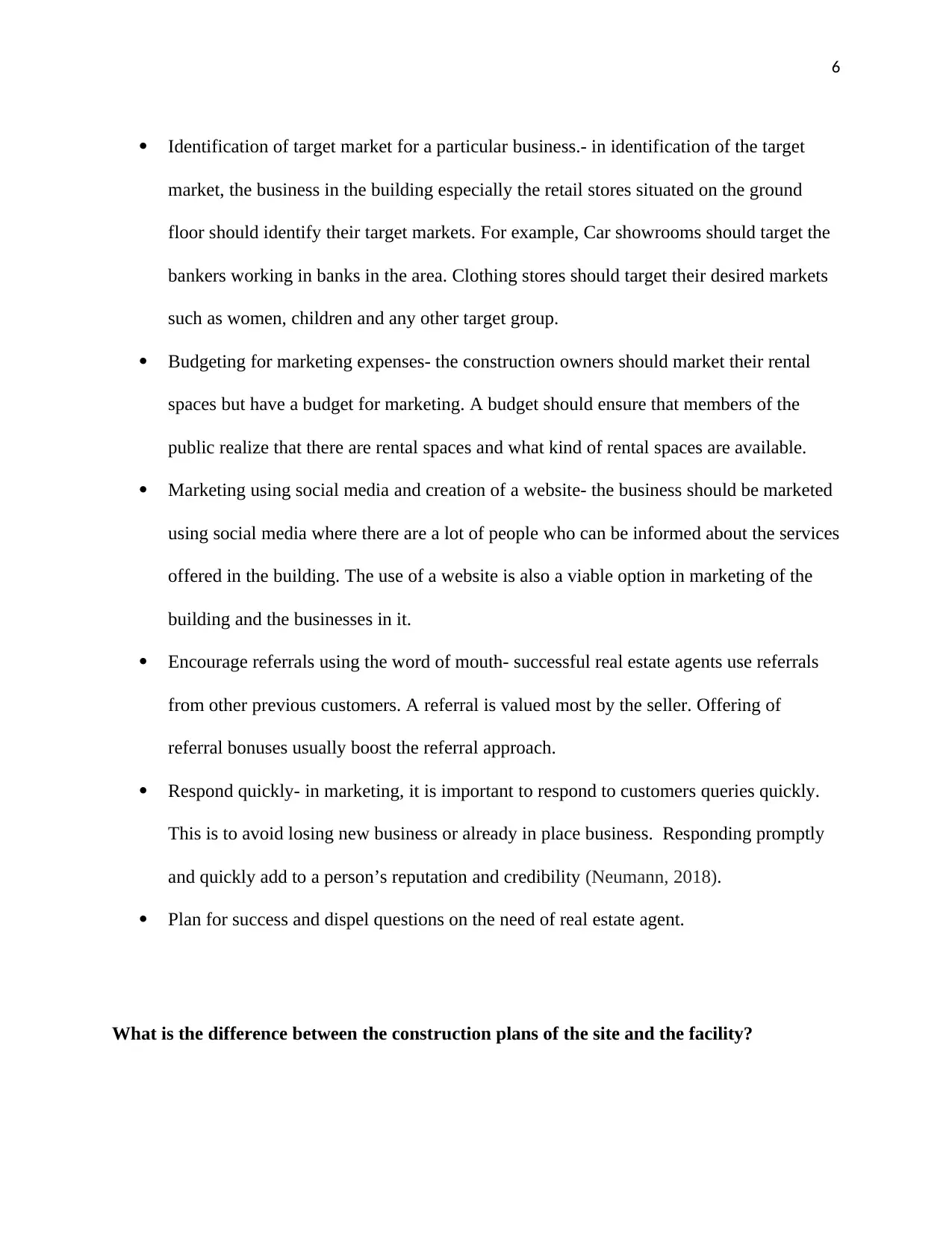
6
Identification of target market for a particular business.- in identification of the target
market, the business in the building especially the retail stores situated on the ground
floor should identify their target markets. For example, Car showrooms should target the
bankers working in banks in the area. Clothing stores should target their desired markets
such as women, children and any other target group.
Budgeting for marketing expenses- the construction owners should market their rental
spaces but have a budget for marketing. A budget should ensure that members of the
public realize that there are rental spaces and what kind of rental spaces are available.
Marketing using social media and creation of a website- the business should be marketed
using social media where there are a lot of people who can be informed about the services
offered in the building. The use of a website is also a viable option in marketing of the
building and the businesses in it.
Encourage referrals using the word of mouth- successful real estate agents use referrals
from other previous customers. A referral is valued most by the seller. Offering of
referral bonuses usually boost the referral approach.
Respond quickly- in marketing, it is important to respond to customers queries quickly.
This is to avoid losing new business or already in place business. Responding promptly
and quickly add to a person’s reputation and credibility (Neumann, 2018).
Plan for success and dispel questions on the need of real estate agent.
What is the difference between the construction plans of the site and the facility?
Identification of target market for a particular business.- in identification of the target
market, the business in the building especially the retail stores situated on the ground
floor should identify their target markets. For example, Car showrooms should target the
bankers working in banks in the area. Clothing stores should target their desired markets
such as women, children and any other target group.
Budgeting for marketing expenses- the construction owners should market their rental
spaces but have a budget for marketing. A budget should ensure that members of the
public realize that there are rental spaces and what kind of rental spaces are available.
Marketing using social media and creation of a website- the business should be marketed
using social media where there are a lot of people who can be informed about the services
offered in the building. The use of a website is also a viable option in marketing of the
building and the businesses in it.
Encourage referrals using the word of mouth- successful real estate agents use referrals
from other previous customers. A referral is valued most by the seller. Offering of
referral bonuses usually boost the referral approach.
Respond quickly- in marketing, it is important to respond to customers queries quickly.
This is to avoid losing new business or already in place business. Responding promptly
and quickly add to a person’s reputation and credibility (Neumann, 2018).
Plan for success and dispel questions on the need of real estate agent.
What is the difference between the construction plans of the site and the facility?
⊘ This is a preview!⊘
Do you want full access?
Subscribe today to unlock all pages.

Trusted by 1+ million students worldwide
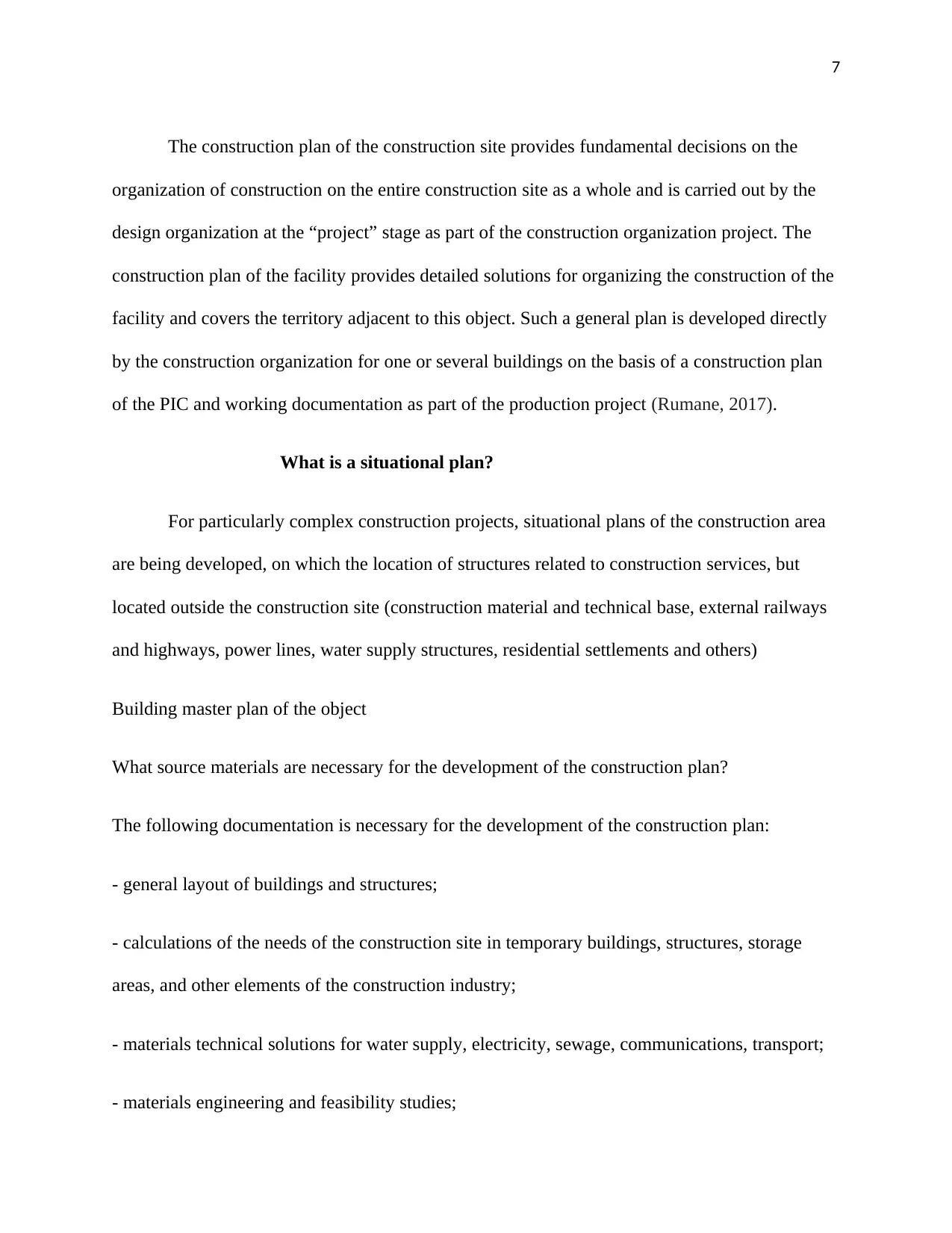
7
The construction plan of the construction site provides fundamental decisions on the
organization of construction on the entire construction site as a whole and is carried out by the
design organization at the “project” stage as part of the construction organization project. The
construction plan of the facility provides detailed solutions for organizing the construction of the
facility and covers the territory adjacent to this object. Such a general plan is developed directly
by the construction organization for one or several buildings on the basis of a construction plan
of the PIC and working documentation as part of the production project (Rumane, 2017).
What is a situational plan?
For particularly complex construction projects, situational plans of the construction area
are being developed, on which the location of structures related to construction services, but
located outside the construction site (construction material and technical base, external railways
and highways, power lines, water supply structures, residential settlements and others)
Building master plan of the object
What source materials are necessary for the development of the construction plan?
The following documentation is necessary for the development of the construction plan:
- general layout of buildings and structures;
- calculations of the needs of the construction site in temporary buildings, structures, storage
areas, and other elements of the construction industry;
- materials technical solutions for water supply, electricity, sewage, communications, transport;
- materials engineering and feasibility studies;
The construction plan of the construction site provides fundamental decisions on the
organization of construction on the entire construction site as a whole and is carried out by the
design organization at the “project” stage as part of the construction organization project. The
construction plan of the facility provides detailed solutions for organizing the construction of the
facility and covers the territory adjacent to this object. Such a general plan is developed directly
by the construction organization for one or several buildings on the basis of a construction plan
of the PIC and working documentation as part of the production project (Rumane, 2017).
What is a situational plan?
For particularly complex construction projects, situational plans of the construction area
are being developed, on which the location of structures related to construction services, but
located outside the construction site (construction material and technical base, external railways
and highways, power lines, water supply structures, residential settlements and others)
Building master plan of the object
What source materials are necessary for the development of the construction plan?
The following documentation is necessary for the development of the construction plan:
- general layout of buildings and structures;
- calculations of the needs of the construction site in temporary buildings, structures, storage
areas, and other elements of the construction industry;
- materials technical solutions for water supply, electricity, sewage, communications, transport;
- materials engineering and feasibility studies;
Paraphrase This Document
Need a fresh take? Get an instant paraphrase of this document with our AI Paraphraser
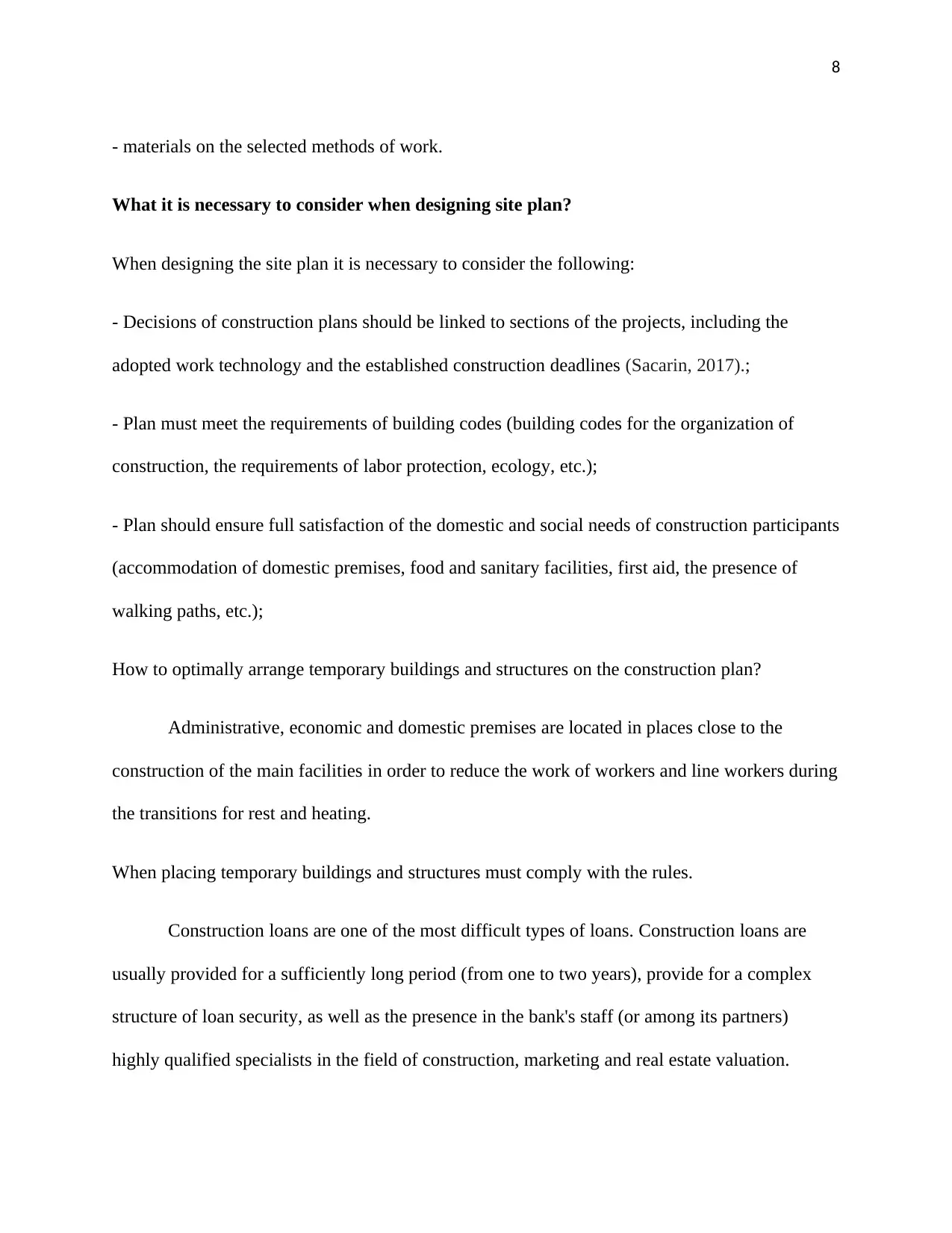
8
- materials on the selected methods of work.
What it is necessary to consider when designing site plan?
When designing the site plan it is necessary to consider the following:
- Decisions of construction plans should be linked to sections of the projects, including the
adopted work technology and the established construction deadlines (Sacarin, 2017).;
- Plan must meet the requirements of building codes (building codes for the organization of
construction, the requirements of labor protection, ecology, etc.);
- Plan should ensure full satisfaction of the domestic and social needs of construction participants
(accommodation of domestic premises, food and sanitary facilities, first aid, the presence of
walking paths, etc.);
How to optimally arrange temporary buildings and structures on the construction plan?
Administrative, economic and domestic premises are located in places close to the
construction of the main facilities in order to reduce the work of workers and line workers during
the transitions for rest and heating.
When placing temporary buildings and structures must comply with the rules.
Construction loans are one of the most difficult types of loans. Construction loans are
usually provided for a sufficiently long period (from one to two years), provide for a complex
structure of loan security, as well as the presence in the bank's staff (or among its partners)
highly qualified specialists in the field of construction, marketing and real estate valuation.
- materials on the selected methods of work.
What it is necessary to consider when designing site plan?
When designing the site plan it is necessary to consider the following:
- Decisions of construction plans should be linked to sections of the projects, including the
adopted work technology and the established construction deadlines (Sacarin, 2017).;
- Plan must meet the requirements of building codes (building codes for the organization of
construction, the requirements of labor protection, ecology, etc.);
- Plan should ensure full satisfaction of the domestic and social needs of construction participants
(accommodation of domestic premises, food and sanitary facilities, first aid, the presence of
walking paths, etc.);
How to optimally arrange temporary buildings and structures on the construction plan?
Administrative, economic and domestic premises are located in places close to the
construction of the main facilities in order to reduce the work of workers and line workers during
the transitions for rest and heating.
When placing temporary buildings and structures must comply with the rules.
Construction loans are one of the most difficult types of loans. Construction loans are
usually provided for a sufficiently long period (from one to two years), provide for a complex
structure of loan security, as well as the presence in the bank's staff (or among its partners)
highly qualified specialists in the field of construction, marketing and real estate valuation.
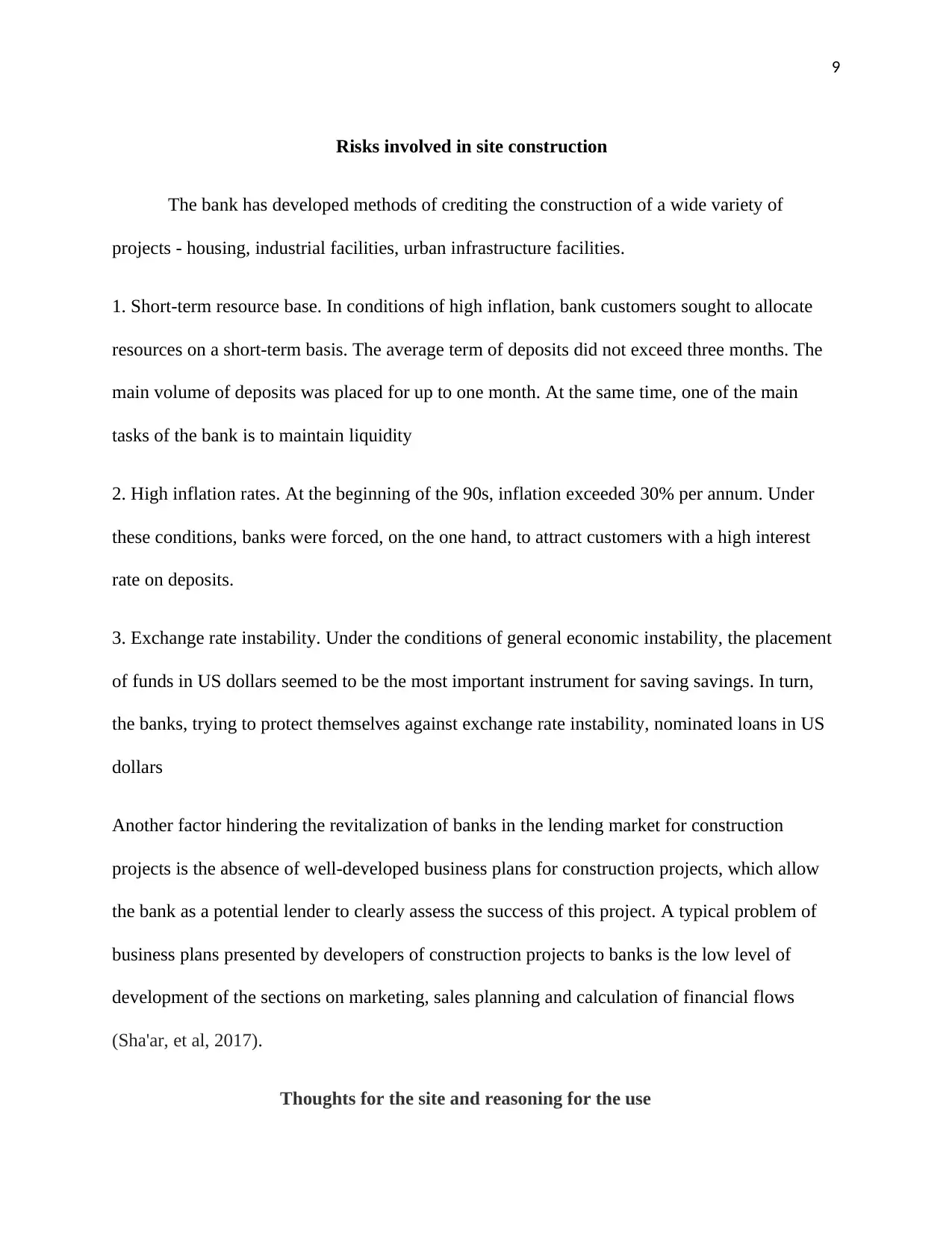
9
Risks involved in site construction
The bank has developed methods of crediting the construction of a wide variety of
projects - housing, industrial facilities, urban infrastructure facilities.
1. Short-term resource base. In conditions of high inflation, bank customers sought to allocate
resources on a short-term basis. The average term of deposits did not exceed three months. The
main volume of deposits was placed for up to one month. At the same time, one of the main
tasks of the bank is to maintain liquidity
2. High inflation rates. At the beginning of the 90s, inflation exceeded 30% per annum. Under
these conditions, banks were forced, on the one hand, to attract customers with a high interest
rate on deposits.
3. Exchange rate instability. Under the conditions of general economic instability, the placement
of funds in US dollars seemed to be the most important instrument for saving savings. In turn,
the banks, trying to protect themselves against exchange rate instability, nominated loans in US
dollars
Another factor hindering the revitalization of banks in the lending market for construction
projects is the absence of well-developed business plans for construction projects, which allow
the bank as a potential lender to clearly assess the success of this project. A typical problem of
business plans presented by developers of construction projects to banks is the low level of
development of the sections on marketing, sales planning and calculation of financial flows
(Sha'ar, et al, 2017).
Thoughts for the site and reasoning for the use
Risks involved in site construction
The bank has developed methods of crediting the construction of a wide variety of
projects - housing, industrial facilities, urban infrastructure facilities.
1. Short-term resource base. In conditions of high inflation, bank customers sought to allocate
resources on a short-term basis. The average term of deposits did not exceed three months. The
main volume of deposits was placed for up to one month. At the same time, one of the main
tasks of the bank is to maintain liquidity
2. High inflation rates. At the beginning of the 90s, inflation exceeded 30% per annum. Under
these conditions, banks were forced, on the one hand, to attract customers with a high interest
rate on deposits.
3. Exchange rate instability. Under the conditions of general economic instability, the placement
of funds in US dollars seemed to be the most important instrument for saving savings. In turn,
the banks, trying to protect themselves against exchange rate instability, nominated loans in US
dollars
Another factor hindering the revitalization of banks in the lending market for construction
projects is the absence of well-developed business plans for construction projects, which allow
the bank as a potential lender to clearly assess the success of this project. A typical problem of
business plans presented by developers of construction projects to banks is the low level of
development of the sections on marketing, sales planning and calculation of financial flows
(Sha'ar, et al, 2017).
Thoughts for the site and reasoning for the use
⊘ This is a preview!⊘
Do you want full access?
Subscribe today to unlock all pages.

Trusted by 1+ million students worldwide
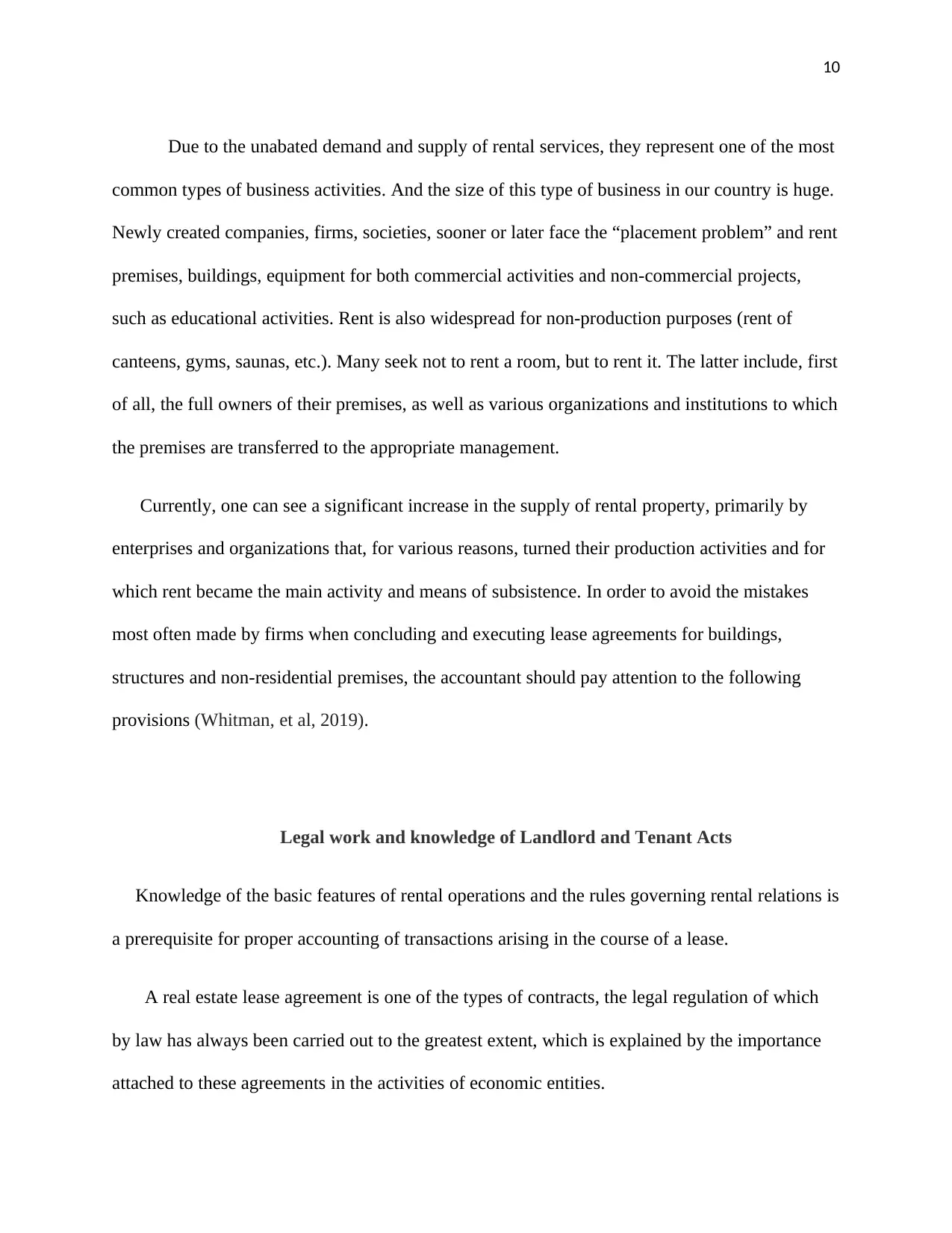
10
Due to the unabated demand and supply of rental services, they represent one of the most
common types of business activities. And the size of this type of business in our country is huge.
Newly created companies, firms, societies, sooner or later face the “placement problem” and rent
premises, buildings, equipment for both commercial activities and non-commercial projects,
such as educational activities. Rent is also widespread for non-production purposes (rent of
canteens, gyms, saunas, etc.). Many seek not to rent a room, but to rent it. The latter include, first
of all, the full owners of their premises, as well as various organizations and institutions to which
the premises are transferred to the appropriate management.
Currently, one can see a significant increase in the supply of rental property, primarily by
enterprises and organizations that, for various reasons, turned their production activities and for
which rent became the main activity and means of subsistence. In order to avoid the mistakes
most often made by firms when concluding and executing lease agreements for buildings,
structures and non-residential premises, the accountant should pay attention to the following
provisions (Whitman, et al, 2019).
Legal work and knowledge of Landlord and Tenant Acts
Knowledge of the basic features of rental operations and the rules governing rental relations is
a prerequisite for proper accounting of transactions arising in the course of a lease.
A real estate lease agreement is one of the types of contracts, the legal regulation of which
by law has always been carried out to the greatest extent, which is explained by the importance
attached to these agreements in the activities of economic entities.
Due to the unabated demand and supply of rental services, they represent one of the most
common types of business activities. And the size of this type of business in our country is huge.
Newly created companies, firms, societies, sooner or later face the “placement problem” and rent
premises, buildings, equipment for both commercial activities and non-commercial projects,
such as educational activities. Rent is also widespread for non-production purposes (rent of
canteens, gyms, saunas, etc.). Many seek not to rent a room, but to rent it. The latter include, first
of all, the full owners of their premises, as well as various organizations and institutions to which
the premises are transferred to the appropriate management.
Currently, one can see a significant increase in the supply of rental property, primarily by
enterprises and organizations that, for various reasons, turned their production activities and for
which rent became the main activity and means of subsistence. In order to avoid the mistakes
most often made by firms when concluding and executing lease agreements for buildings,
structures and non-residential premises, the accountant should pay attention to the following
provisions (Whitman, et al, 2019).
Legal work and knowledge of Landlord and Tenant Acts
Knowledge of the basic features of rental operations and the rules governing rental relations is
a prerequisite for proper accounting of transactions arising in the course of a lease.
A real estate lease agreement is one of the types of contracts, the legal regulation of which
by law has always been carried out to the greatest extent, which is explained by the importance
attached to these agreements in the activities of economic entities.
Paraphrase This Document
Need a fresh take? Get an instant paraphrase of this document with our AI Paraphraser
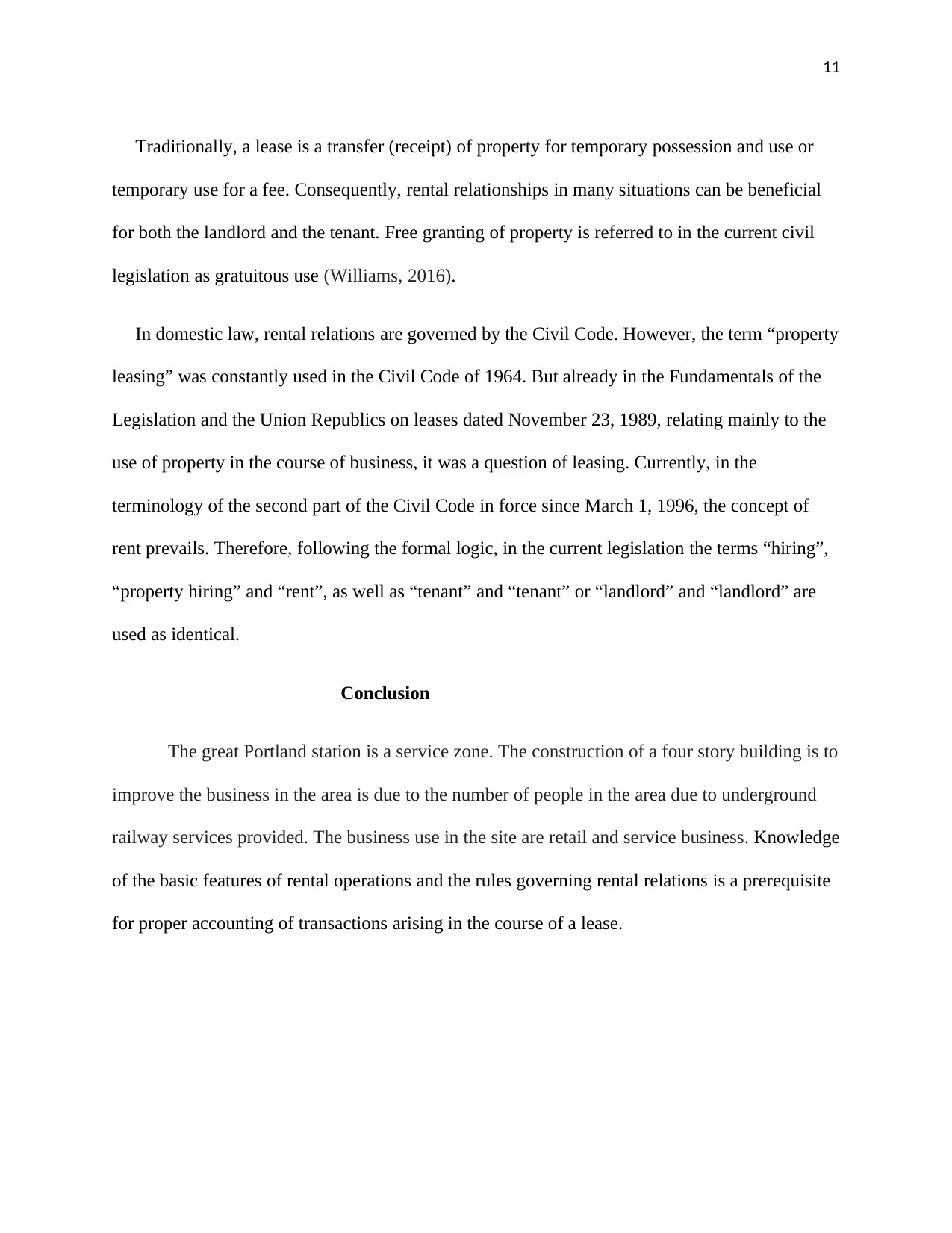
11
Traditionally, a lease is a transfer (receipt) of property for temporary possession and use or
temporary use for a fee. Consequently, rental relationships in many situations can be beneficial
for both the landlord and the tenant. Free granting of property is referred to in the current civil
legislation as gratuitous use (Williams, 2016).
In domestic law, rental relations are governed by the Civil Code. However, the term “property
leasing” was constantly used in the Civil Code of 1964. But already in the Fundamentals of the
Legislation and the Union Republics on leases dated November 23, 1989, relating mainly to the
use of property in the course of business, it was a question of leasing. Currently, in the
terminology of the second part of the Civil Code in force since March 1, 1996, the concept of
rent prevails. Therefore, following the formal logic, in the current legislation the terms “hiring”,
“property hiring” and “rent”, as well as “tenant” and “tenant” or “landlord” and “landlord” are
used as identical.
Conclusion
The great Portland station is a service zone. The construction of a four story building is to
improve the business in the area is due to the number of people in the area due to underground
railway services provided. The business use in the site are retail and service business. Knowledge
of the basic features of rental operations and the rules governing rental relations is a prerequisite
for proper accounting of transactions arising in the course of a lease.
Traditionally, a lease is a transfer (receipt) of property for temporary possession and use or
temporary use for a fee. Consequently, rental relationships in many situations can be beneficial
for both the landlord and the tenant. Free granting of property is referred to in the current civil
legislation as gratuitous use (Williams, 2016).
In domestic law, rental relations are governed by the Civil Code. However, the term “property
leasing” was constantly used in the Civil Code of 1964. But already in the Fundamentals of the
Legislation and the Union Republics on leases dated November 23, 1989, relating mainly to the
use of property in the course of business, it was a question of leasing. Currently, in the
terminology of the second part of the Civil Code in force since March 1, 1996, the concept of
rent prevails. Therefore, following the formal logic, in the current legislation the terms “hiring”,
“property hiring” and “rent”, as well as “tenant” and “tenant” or “landlord” and “landlord” are
used as identical.
Conclusion
The great Portland station is a service zone. The construction of a four story building is to
improve the business in the area is due to the number of people in the area due to underground
railway services provided. The business use in the site are retail and service business. Knowledge
of the basic features of rental operations and the rules governing rental relations is a prerequisite
for proper accounting of transactions arising in the course of a lease.
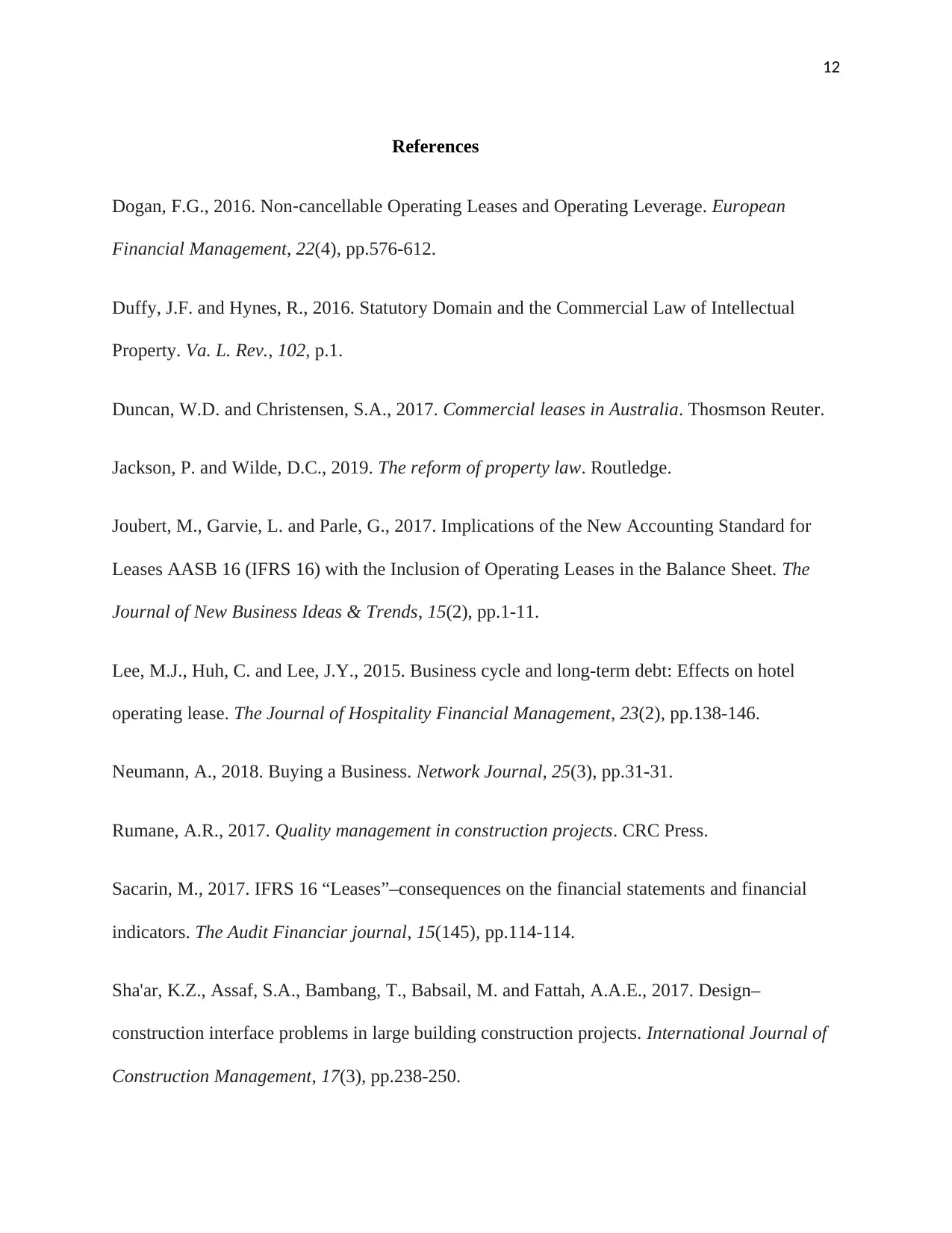
12
References
Dogan, F.G., 2016. Non‐cancellable Operating Leases and Operating Leverage. European
Financial Management, 22(4), pp.576-612.
Duffy, J.F. and Hynes, R., 2016. Statutory Domain and the Commercial Law of Intellectual
Property. Va. L. Rev., 102, p.1.
Duncan, W.D. and Christensen, S.A., 2017. Commercial leases in Australia. Thosmson Reuter.
Jackson, P. and Wilde, D.C., 2019. The reform of property law. Routledge.
Joubert, M., Garvie, L. and Parle, G., 2017. Implications of the New Accounting Standard for
Leases AASB 16 (IFRS 16) with the Inclusion of Operating Leases in the Balance Sheet. The
Journal of New Business Ideas & Trends, 15(2), pp.1-11.
Lee, M.J., Huh, C. and Lee, J.Y., 2015. Business cycle and long-term debt: Effects on hotel
operating lease. The Journal of Hospitality Financial Management, 23(2), pp.138-146.
Neumann, A., 2018. Buying a Business. Network Journal, 25(3), pp.31-31.
Rumane, A.R., 2017. Quality management in construction projects. CRC Press.
Sacarin, M., 2017. IFRS 16 “Leases”–consequences on the financial statements and financial
indicators. The Audit Financiar journal, 15(145), pp.114-114.
Sha'ar, K.Z., Assaf, S.A., Bambang, T., Babsail, M. and Fattah, A.A.E., 2017. Design–
construction interface problems in large building construction projects. International Journal of
Construction Management, 17(3), pp.238-250.
References
Dogan, F.G., 2016. Non‐cancellable Operating Leases and Operating Leverage. European
Financial Management, 22(4), pp.576-612.
Duffy, J.F. and Hynes, R., 2016. Statutory Domain and the Commercial Law of Intellectual
Property. Va. L. Rev., 102, p.1.
Duncan, W.D. and Christensen, S.A., 2017. Commercial leases in Australia. Thosmson Reuter.
Jackson, P. and Wilde, D.C., 2019. The reform of property law. Routledge.
Joubert, M., Garvie, L. and Parle, G., 2017. Implications of the New Accounting Standard for
Leases AASB 16 (IFRS 16) with the Inclusion of Operating Leases in the Balance Sheet. The
Journal of New Business Ideas & Trends, 15(2), pp.1-11.
Lee, M.J., Huh, C. and Lee, J.Y., 2015. Business cycle and long-term debt: Effects on hotel
operating lease. The Journal of Hospitality Financial Management, 23(2), pp.138-146.
Neumann, A., 2018. Buying a Business. Network Journal, 25(3), pp.31-31.
Rumane, A.R., 2017. Quality management in construction projects. CRC Press.
Sacarin, M., 2017. IFRS 16 “Leases”–consequences on the financial statements and financial
indicators. The Audit Financiar journal, 15(145), pp.114-114.
Sha'ar, K.Z., Assaf, S.A., Bambang, T., Babsail, M. and Fattah, A.A.E., 2017. Design–
construction interface problems in large building construction projects. International Journal of
Construction Management, 17(3), pp.238-250.
⊘ This is a preview!⊘
Do you want full access?
Subscribe today to unlock all pages.

Trusted by 1+ million students worldwide
1 out of 13
Your All-in-One AI-Powered Toolkit for Academic Success.
+13062052269
info@desklib.com
Available 24*7 on WhatsApp / Email
![[object Object]](/_next/static/media/star-bottom.7253800d.svg)
Unlock your academic potential
Copyright © 2020–2025 A2Z Services. All Rights Reserved. Developed and managed by ZUCOL.
